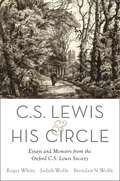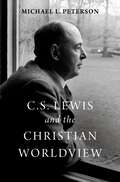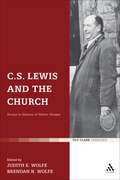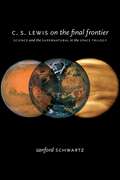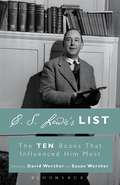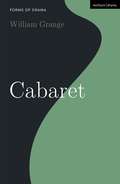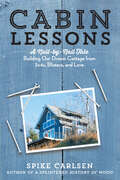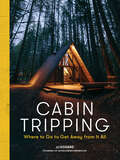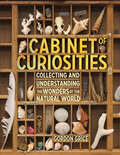- Table View
- List View
Byzantine Media Subjects (Medieval Societies, Religions, and Cultures)
by Glenn A. PeersByzantine Media Subjects invites readers into a world replete with images—icons, frescoes, and mosaics filling places of worship, politics, and community. Glenn Peers asks readers to think themselves into a world where representation reigned and humans followed, and indeed were formed. Interrogating the fundamental role of representation in the making of the Byzantine human, Peers argues that Byzantine culture was (already) posthuman. The Byzantine experience reveals the extent to which media like icons, manuscripts, music, animals, and mirrors fundamentally determine humans. In the Byzantine world, representation as such was deeply persuasive, even coercive; it had the power to affect human relationships, produce conflict, and form self-perception. Media studies has made its subject the modern world, but this book argues for media having made historical subjects. Here, it is shown that media long ago also made Byzantine humans, defining them, molding them, mediating their relationship to time, to nature, to God, and to themselves.
Byzantine Silk on the Silk Roads: Journeys between East and West, Past and Present
by BloomsburyWith over 200 color illustrations, Byzantine Silk on the Silk Roads examines in detail the eclectic iconography of the Byzantine period and its impact on design and creativity today. Through an examination of the extraordinary variety of designs in these captivating silks, an international team of experts reveal that Byzantine culture was ever-moving and open to diverse influences across the length of the Silk Road. Commentaries from curators at key collections – including the Museum of Arts, Boston, the Smithsonian (Cooper Hewitt), the V&A and the Vatican – reveal the spread of silk embroidery and designs from East to West, and from West to East, from China to Rome, and from Constantinople to Korea. Drawing on exclusive imagery from worldwide collections within museums, churches and archives as case studies, their analysis of these unique woven silks explores the relationship between color and power, material culture and status, and offers broader insight into Byzantine culture, trade, society and ceremony. Byzantine Silk … takes us on a journey from the past to the present, too, where Byzantine story-telling and image-making is revisited, through color, imagery and pattern, in contemporary fashion collections. Exploring Byzantine culture through a contemporary filter, the book shows how the Byzantine era still influences textile and fashion designers today in their choices of materials and colors, and their utilization of images and patterns, acting as a unique source of inspiration to designers and creators in the 21st century.
Byzantine Silk on the Silk Roads: Journeys between East and West, Past and Present
With over 200 color illustrations, Byzantine Silk on the Silk Roads examines in detail the eclectic iconography of the Byzantine period and its impact on design and creativity today. Through an examination of the extraordinary variety of designs in these captivating silks, an international team of experts reveal that Byzantine culture was ever-moving and open to diverse influences across the length of the Silk Road. Commentaries from curators at key collections – including the Museum of Arts, Boston, the Smithsonian (Cooper Hewitt), the V&A and the Vatican – reveal the spread of silk embroidery and designs from East to West, and from West to East, from China to Rome, and from Constantinople to Korea. Drawing on exclusive imagery from worldwide collections within museums, churches and archives as case studies, their analysis of these unique woven silks explores the relationship between color and power, material culture and status, and offers broader insight into Byzantine culture, trade, society and ceremony. Byzantine Silk … takes us on a journey from the past to the present, too, where Byzantine story-telling and image-making is revisited, through color, imagery and pattern, in contemporary fashion collections. Exploring Byzantine culture through a contemporary filter, the book shows how the Byzantine era still influences textile and fashion designers today in their choices of materials and colors, and their utilization of images and patterns, acting as a unique source of inspiration to designers and creators in the 21st century.
C# Game Programming Cookbook for Unity 3D
by Jeff W. MurrayAn Accessible, Modular Style of Game Building-Easily Start Making Games with Unity 3DC# Game Programming Cookbook for Unity 3D presents a highly flexible core framework to create just about any type of game by plugging in different script components. Most scripts function within the game framework or in your own structures. The techniques and conce
C# Game Programming Cookbook for Unity 3D
by Jeff W. MurrayAn Accessible, Modular Style of Game Building-Easily Start Making Games with Unity 3DC# Game Programming Cookbook for Unity 3D presents a highly flexible core framework to create just about any type of game by plugging in different script components. Most scripts function within the game framework or in your own structures. The techniques and conce
C Programming: The Essentials for Engineers and Scientists (Undergraduate Texts in Computer Science)
by David R. BrooksThis text teaches the essentials of C programming, concentrating on what readers need to know in order to produce stand-alone programs and so solve typical scientific and engineering problems. It is a learning-by-doing book, with many examples and exercises, and lays a foundation of scientific programming concepts and techniques that will prove valuable for those who might eventually move on to another language. Written for undergraduates who are familiar with computers and typical applications but are new to programming.
C. S. Lewis and His Circle: Essays and Memoirs from the Oxford C.S. Lewis Society
by Roger White, Judith Wolfe and Brendan N. WolfeFor over thirty years, the Oxford C. S. Lewis Society has met weekly in the medieval colleges of the University of Oxford. During that time, it has hosted as speakers nearly all those still living who were associated with the Inklings-the Oxford literary circle led by C. S. Lewis--as well as authors and thinkers of a prominence that nears Lewis's own. C. S. Lewis and His Circle offers the reader a chance to join this unique group. Roger White has worked with Society past presidents Brendan and Judith Wolfe to select the most important talks, which are here made available to the wider public for the first time. They exemplify the best of traditional academic essays, thoughtful memoirs, and informal reminiscences about C. S. Lewis and his circle. The reader will reimagine Lewis's Cosmic Trilogy with former Archbishop of Canterbury Rowan Williams, read philosopher Elizabeth Anscombe's final word on Lewis's arguments for Christianity, hear the Reverend Peter Bide's memories of marrying Lewis and Joy Davidman in an Oxford hospital, and learn about Lewis's Narnia Chronicles from his former secretary. Representing the finest of both personal and scholarly engagement with C. S. Lewis and the Inklings, the talks collected here set a new tone for engagement with this iconic Oxford literary circle--a tone close to Lewis's own Oxford--bred sharpness and wryness, seasoned with good humor and genuine affection for C. S. Lewis and his circle.
C. S. Lewis and His Circle: Essays and Memoirs from the Oxford C.S. Lewis Society
by Roger White Judith Wolfe Brendan WolfeFor over thirty years, the Oxford C. S. Lewis Society has met weekly in the medieval colleges of the University of Oxford. During that time, it has hosted as speakers nearly all those still living who were associated with the Inklings-the Oxford literary circle led by C. S. Lewis--as well as authors and thinkers of a prominence that nears Lewis's own. C. S. Lewis and His Circle offers the reader a chance to join this unique group. Roger White has worked with Society past presidents Brendan and Judith Wolfe to select the most important talks, which are here made available to the wider public for the first time. They exemplify the best of traditional academic essays, thoughtful memoirs, and informal reminiscences about C. S. Lewis and his circle. The reader will reimagine Lewis's Cosmic Trilogy with former Archbishop of Canterbury Rowan Williams, read philosopher Elizabeth Anscombe's final word on Lewis's arguments for Christianity, hear the Reverend Peter Bide's memories of marrying Lewis and Joy Davidman in an Oxford hospital, and learn about Lewis's Narnia Chronicles from his former secretary. Representing the finest of both personal and scholarly engagement with C. S. Lewis and the Inklings, the talks collected here set a new tone for engagement with this iconic Oxford literary circle--a tone close to Lewis's own Oxford--bred sharpness and wryness, seasoned with good humor and genuine affection for C. S. Lewis and his circle.
C. S. Lewis and the Christian Worldview
by Michael L. PetersonC. S. Lewis is one of the most influential and beloved Christian writers of the past century, and interest in him continues to grow as books about his fantasy, fiction, and biography continue to appear. Although Lewis's personal journey was a deeply philosophical search for the most adequate worldview, the few extant books about his Christian philosophy focus on specific topics rather than his overall worldview. In this book, Michael Peterson develops a comprehensive framework for understanding Lewis's Christian worldview--from his arguments from reason, morality, and desire to his ideas about Incarnation, Trinity, and Atonement. All worldviews address fundamental questions about reality, knowledge, human nature, meaning, and so forth. Peterson therefore examines Lewis's Christian approach to these same questions in interaction with other worldviews. Accenting that the intellectual strength and existential relevance of Lewis's works rest on his philosophical acumen as well as his Christian orthodoxy--which he famously called "mere Christianity"--Peterson skillfully shows how Lewis's Christian thought engages a variety of important problems raised by believers and nonbelievers alike: the problem of evil and suffering, the problem of religious diversity, the problem of meaning, and others. Just as Lewis was gifted in communicating philosophical ideas and arguments in an accessible style, Peterson has crafted a major contribution to Lewis scholarship presented in a way that will interest scholars and benefit the general reader.
C. S. Lewis and the Christian Worldview
by Michael L. PetersonC. S. Lewis is one of the most influential and beloved Christian writers of the past century, and interest in him continues to grow as books about his fantasy, fiction, and biography continue to appear. Although Lewis's personal journey was a deeply philosophical search for the most adequate worldview, the few extant books about his Christian philosophy focus on specific topics rather than his overall worldview. In this book, Michael Peterson develops a comprehensive framework for understanding Lewis's Christian worldview--from his arguments from reason, morality, and desire to his ideas about Incarnation, Trinity, and Atonement. All worldviews address fundamental questions about reality, knowledge, human nature, meaning, and so forth. Peterson therefore examines Lewis's Christian approach to these same questions in interaction with other worldviews. Accenting that the intellectual strength and existential relevance of Lewis's works rest on his philosophical acumen as well as his Christian orthodoxy--which he famously called "mere Christianity"--Peterson skillfully shows how Lewis's Christian thought engages a variety of important problems raised by believers and nonbelievers alike: the problem of evil and suffering, the problem of religious diversity, the problem of meaning, and others. Just as Lewis was gifted in communicating philosophical ideas and arguments in an accessible style, Peterson has crafted a major contribution to Lewis scholarship presented in a way that will interest scholars and benefit the general reader.
C.S. Lewis and the Church: Essays in Honour of Walter Hooper
by Judith Wolfe Brendan N. WolfeC.S. Lewis, himself a layperson in the Church of England, has exercised an unprecedentedly wide influence on the faithful of Anglican, Roman Catholic, Evangelical and other churches, all of whom tend naturally to claim him as 'one of their own'. One of the reasons for this diverse appropriation is the elusiveness of the church-in the sense both of his own denomination and of the wider subject of ecclesiology-in Lewis' writings. The essays contained in this volume critically examine the place, character and role of the Church in Lewis' life. The result is a detailed and scintillating picture of the interactions of one of the most distinctive voices in 20th-century theology with the contemporaneous development of the Church of England, with key concepts in ecclesiology, and with interdenominational matters.
C. S. Lewis on the Final Frontier: Science and the Supernatural in the Space Trilogy
by Sanford SchwartzSanford Schwartz offers a penetrating new reading of Lewis's celebrated Space Trilogy. Taken together, Schwartz's readings call into question Lewis's self-styled image as a "dinosaur" out of step with the main currents of modern thought. Far from a simple struggle between an old-fashioned Christian humanism and a newfangled heresy, Lewis's Space Trilogy should be seen as the searching effort of a modern religious apologist to sustain and enrich the former through critical engagement with the latter.
C. S. Lewis on the Final Frontier: Science and the Supernatural in the Space Trilogy
by Sanford SchwartzSanford Schwartz offers a penetrating new reading of Lewis's celebrated Space Trilogy. Taken together, Schwartz's readings call into question Lewis's self-styled image as a "dinosaur" out of step with the main currents of modern thought. Far from a simple struggle between an old-fashioned Christian humanism and a newfangled heresy, Lewis's Space Trilogy should be seen as the searching effort of a modern religious apologist to sustain and enrich the former through critical engagement with the latter.
C. S. Lewis's List: The Ten Books That Influenced Him Most
by David Werther Susan WertherIn 1962, The Christian Century published C. S. Lewis's answer to the question, "What books did most to shape your vocational attitude and your philosophy of life?†? Lewis responded with ten titles, ranging from Virgil's Aeneid to James Boswell's The Life of Samuel Johnson and from George Herbert's The Temple to Boethius's The Consolation of Philosophy. C. S. Lewis's List brings together experts on each of the ten books to discuss their significance for Lewis's life and work, illuminating his own writing through those he most admired.
C. S. Lewis's List: The Ten Books That Influenced Him Most
by David Werther Susan WertherIn 1962, The Christian Century published C. S. Lewis's answer to the question, “What books did most to shape your vocational attitude and your philosophy of life?” Lewis responded with ten titles, ranging from Virgil's Aeneid to James Boswell's The Life of Samuel Johnson and from George Herbert's The Temple to Boethius's The Consolation of Philosophy. C. S. Lewis's List brings together experts on each of the ten books to discuss their significance for Lewis's life and work, illuminating his own writing through those he most admired.
CA-Integration in Theorie und Praxis: Aktuelle Konzepte für Integrations- und Kommunikationstechnologien im CAD-Umfeld (Beiträge zur Graphischen Datenverarbeitung)
by Ute Dietrich Bernd Kehrer Gerhard VatterrottDie Beiträge dieses Buches vermitteln einen Überblick über aktuelle Konzepte, Entwicklungen und Probleme im Bereich der Kommunikation und Kooperation von CAD-Systemen und -Benutzern sowie der Integration von CA-Systemen in industriellen Prozeßketten. Schwerpunkte sind dabei Konzepte und Forschungsergebnisse zum rechnergestützten kooperativen Arbeiten in CAD sowie zu Produktdatenmodellierung und -management als wesentliche Voraussetzungen für die Integration von CA-Prozessen. In diesem Kontext werden die Bedeutung des internationalen Produktmodellierungsstandards STEP sowie dessen Fähigkeiten für die CA-Integration kritisch gewürdigt.
CAAD futures 1997: Proceedings of the 7th International Conference on Computer Aided Architectural Design Futures held in Munich, Germany, 4–6 August 1997
by Richard JungeSince the establishment of the CAAD futures Foundation in 1985 CAAD experts from all over the world meet every two years to present and at the same time document the state of art of research in Computer Aided Architectural Design. The history of CAAD futures started in the Netherlands at the Technical Universities of Eindhoven and Delft, where the CAAD futures Foundation came into being. Then CAAD futures crossed the oceans for the first time, the third CAAD futures in 1989 was held at Harvard University. Next stations in the evolution were in 1991 Swiss Federal Institute of Technology, the ETC, Zürich. In 1993 the conference was organized by Carnegie Mellon University, Pittsburgh and in 1995 by National University, Singapore, CAAD futures 1995 marked the world wide nature by organizing it for the first time in Asia. Proceedings of CAAD futures held biannually provide a complete review of the state of research in Computer Aided Architectural Design.
Cabaret (Forms of Drama)
by William GrangeWhere did cabaret come from? What has it got to do with pre-war Berlin, decadent society and Nazis? How does it turn into media cabaret and the sisterhood of sleaze? Is cabaret a primary vehicle for exploring the range of sexual practices and alternative sexual identities?In this new book William Grange brings into one place for the first time the range of practices now associated with the form of cabaret. Beginning with its origins in speciality German theatres and the development both of the sheet music industry and disc recordings, Grange tracks the form through into its golden age in the 1920s and beyond.The book's three sections deal first with the emergence of Berlin as the 'German Chicago', where cabaret flourished in the midst of post-war political turmoil. The abolition of censorship allowed nude dancing and sexually explicit songs and routines. It also saw the introduction of kick-line dancing and black performers. In the book's second and third sections Grange takes the story forward into the post second-world-war world, describing how the form moved outwards from central Europe to move across the whole world, reaching Singapore and Australia, and as it did so settling into the range of forms in which we know it today. Some of these forms became 'media cabaret' looking towards the new media age, the postmodernism that followed on from modernism. To this age, even in its new forms, cabaret brought its old habits of making challenges to assumptions around gender identities and sexual practices. As throughout its whole history, cabaret was a form that provided particular vehicles for female performers. And whereas it once served up whore songs and nude dancing it now offers a sisterhood of sleaze.
Cabaret (Forms of Drama)
by William GrangeWhere did cabaret come from? What has it got to do with pre-war Berlin, decadent society and Nazis? How does it turn into media cabaret and the sisterhood of sleaze? Is cabaret a primary vehicle for exploring the range of sexual practices and alternative sexual identities?In this new book William Grange brings into one place for the first time the range of practices now associated with the form of cabaret. Beginning with its origins in speciality German theatres and the development both of the sheet music industry and disc recordings, Grange tracks the form through into its golden age in the 1920s and beyond.The book's three sections deal first with the emergence of Berlin as the 'German Chicago', where cabaret flourished in the midst of post-war political turmoil. The abolition of censorship allowed nude dancing and sexually explicit songs and routines. It also saw the introduction of kick-line dancing and black performers. In the book's second and third sections Grange takes the story forward into the post second-world-war world, describing how the form moved outwards from central Europe to move across the whole world, reaching Singapore and Australia, and as it did so settling into the range of forms in which we know it today. Some of these forms became 'media cabaret' looking towards the new media age, the postmodernism that followed on from modernism. To this age, even in its new forms, cabaret brought its old habits of making challenges to assumptions around gender identities and sexual practices. As throughout its whole history, cabaret was a form that provided particular vehicles for female performers. And whereas it once served up whore songs and nude dancing it now offers a sisterhood of sleaze.
The Cabin in the Woods (Devil's Advocates)
by Susanne KordThe Cabin in the Woods (2012), directed by Drew Goddard and co-authored by Goddard and Joss Whedon of Buffy-fame, was famously described by co-author Whedon as his ‘loving hate letter’ to horror. Interviews with Whedon reveal that his struggles with modern cinematic horror are not merely emotional, but intensely philosophical. This book is the first to read Cabin as a philosophical metatext that asks what horror offers audiences and why audiences accept. Like any good philosophy, the film offers no answers but raises questions: what ‘choices’ are possible in a pre-determined universe? How do we, the audience, see the victims of violence, and with what ethical consequences? And finally, the most fraught question of all: why do we keep looking?
Cabin Lessons: A Nail-by-Nail Tale: Building Our Dream Cottage from 2x4s, Blisters, and Love
by Spike CarlsenWhen carpenter Spike Carlsen and his wife set out with their recently blended family of five kids to build a cabin on the north shore of Lake Superior, they quickly realized that painting, parenting, and putting up drywall all come with both frustrations and unexpected rewards. Part building guide and part memoir, Cabin Lessons tells the wryly funny, heartwarming story of their eventful journey — from buying an unforgiving plot of land on an eroding cliff to (finally) enjoying the lakeside hideaway of their dreams.
Cabin Tripping: Where to Go to Get Away from It All
by JJ EggersA lushly photographed and detailed inspirational gift book featuring over 80 spectacular cabins around the world, all available to rent.
Cabinet of Curiosities: Collecting and Understanding the Wonders of the Natural World
by Gordon GriceExactly the book for every young explorer who loves finding stuff in nature and bringing it home. Cabinet of Curiosities is a lavishly illustrated introduction to the wonders of natural history and the joys of being an amateur scientist and collector. Nature writer Gordon Grice, who started his first cabinet of curiosities at age six when he found a skunk&’s skull, explains how scientists classify all living things through the Linnaeus system; how to tell real gold from fool&’s gold; how to preserve butterflies, crab shells, feathers, a robin&’s egg, spider specimens, and honeycombs; how to identify seashells; the difference between antlers and horns; how to read animal tracks. And then, what to do with your specimens, including how to build a cabinet of curiosities out of common household objects, like a desk organizer or a box for fishing tackle.
Cable Knitting Stitch Dictionary: 100 essential stitches with actual-size swatches and charts
by Debbie TomkiesKnitted cables are fascinating to knitters of all abilities and this handy cable knitting stitch dictionary is the perfect reference guide. Packed with over 100 cable stitches, it covers everything from timeless classics to exciting, contemporary stitches.The Cable Knitting Stitch Dictionary covers all the essential skills needed to produce successful cables, such as cable terminology, how to read and follow cable charts, spotting and correcting errors, and handy tips and tricks for beginners.There are skill level flags so readers can learn as they go, and mix and match ideas for combining different cable designs. As well as the written patterns there are charts for each of the designs alongside life-size photography of the knitted samples stitched up in high-definition yarn.The book begins with a series of classic cables and then moves on to more detailed cables progressing in complexity from combination cables and panels to all over designs and motifs. It then moves on to explaining how to incorporate other techniques like colorwork. The key stitches required are explained with step-by-step photography and instructions. And there is a chapter about creating your own designs with cables which explores how to chart your own cables, how cables affect the drape of the fabric and ways to adapt this, choosing the right yarn and cable placement.The ‘mix and match’ feature for combining cables flags the row pattern repeat and stitch multiples so you can see if it would work in a specific project. There is also information about the stocking stitch equivalent which is essential when doing a gauge swatch in order to know how wide the cable pattern should be.By taking the best of the traditional cable designs and blending them with contemporary cables, this collection will be a valued reference for any knitter.
Cable Left, Cable Right: 94 Knitted Cables
by Judith DurantA popular design element in many of today's garments and home dec items, as well as an iconic part of many different knitting traditions, cables add drama and texture to knitted fabric. Cable Left, Cable Right takes the mystery out of how to create and design them, for all levels of knitting skill.




